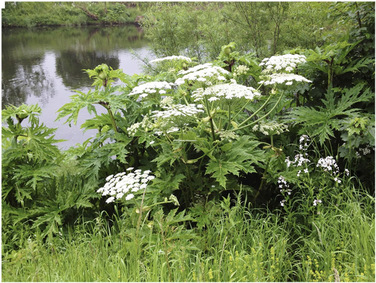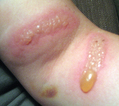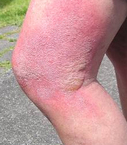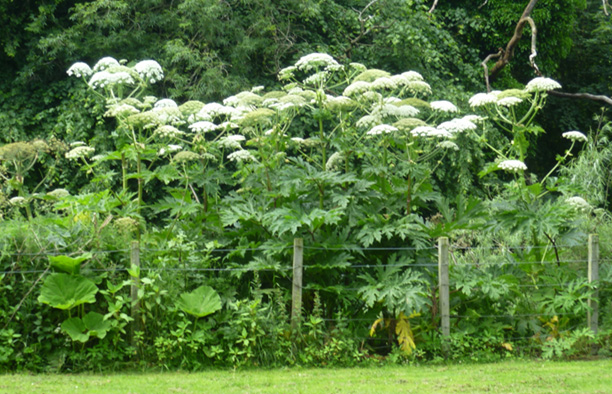The main training season for gundogs is in the summer (the winter is more the working season although training continues throughout the year!!) One of the places we go training has, without extreme care, become potentially very dangerous! The hazard was present last year, but is much worse this year because nobody has done anything about it!! Why? Because landowners have no legal obligation to deal with this hazard, their only obligation is to prevent it from spreading on to other landowners’ property. In my experience they are failing to do so!!
So what is this danger? ..
So what is this danger? ..
GIANT HOGWEED
(Heracleum mantegazzianum)
(Heracleum mantegazzianum)
This non-native species was apparently introduced, from Russia, by the Victorians who thought it would be a stunning architectural plant for their gardens., but it has proven to be a nasty, dangerous and highly invasive species. It is a PHOTOTOXIC plant which means the sap becomes toxic when exposed to UV rays. Its sap causes horrible blistering burns. This plant is a member of the UMBELLIFERAE (e.g. cow parsley, hogweed, fennel and ground elder) family and can grow up to 5 METRES in height!!
If your skin should come into contact with the sap of this plant, within about 24 hours blistering will occur. Depending upon the degree of contact, you may end up with . .
If your skin should come into contact with the sap of this plant, within about 24 hours blistering will occur. Depending upon the degree of contact, you may end up with . .
and you may, or may not, need hospital treatment.
The blistering can last for many months, but the overall effect will last for about 2-3 years provided you always cover up when you go outside If you do not do so, the sunlight will reactivate the blisters and you will be back to “square one”. Permanent effects can include scarring and/or a change in pigmentation of the skin. The sap of the whole plant is dangerous, but the lower part of the hollow stems and petioles, hollow hairs on the plant, foliage, stem, flower and fruit (seed) have the highest concentration and so most serious adverse effects.
This Plant is difficult to miss when fully grown, due to its size, but early in the season it is easily overlooked in undergrowth; it is commonly found along river banks (although in other places too) and spreads easily as it may have as many as 50,000 seeds which can float downstream, or be easily dispersed by the wind, and create more colonies of the plant.
The blistering can last for many months, but the overall effect will last for about 2-3 years provided you always cover up when you go outside If you do not do so, the sunlight will reactivate the blisters and you will be back to “square one”. Permanent effects can include scarring and/or a change in pigmentation of the skin. The sap of the whole plant is dangerous, but the lower part of the hollow stems and petioles, hollow hairs on the plant, foliage, stem, flower and fruit (seed) have the highest concentration and so most serious adverse effects.
This Plant is difficult to miss when fully grown, due to its size, but early in the season it is easily overlooked in undergrowth; it is commonly found along river banks (although in other places too) and spreads easily as it may have as many as 50,000 seeds which can float downstream, or be easily dispersed by the wind, and create more colonies of the plant.
Typical stock fences are between 3ft 6in and 4 ft so you can see how big these specimens are, and they can get a lot bigger too.
So . . . please BE AWARE and TAKE CARE. (This plant affects animals too)
Have a look at the following links for more information :
Video and very comprehensive information - http://www.thepoisongarden.co.uk/atoz/heracleum_mantegazzianum.htm
Other links –
http://www.ceh.ac.uk/sci_programmes/documents/gianthogweed.pdf
https://www.gov.uk/japanese-knotweed-giant-hogweed-and-other-invasive-plants
https://secure.fera.defra.gov.uk/nonnativespecies/index.cfm?pageid=152
http://japaneseknotweed.com/giant-hogweed-identification/
So . . . please BE AWARE and TAKE CARE. (This plant affects animals too)
Have a look at the following links for more information :
Video and very comprehensive information - http://www.thepoisongarden.co.uk/atoz/heracleum_mantegazzianum.htm
Other links –
http://www.ceh.ac.uk/sci_programmes/documents/gianthogweed.pdf
https://www.gov.uk/japanese-knotweed-giant-hogweed-and-other-invasive-plants
https://secure.fera.defra.gov.uk/nonnativespecies/index.cfm?pageid=152
http://japaneseknotweed.com/giant-hogweed-identification/





 RSS Feed
RSS Feed
